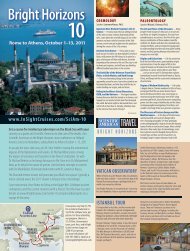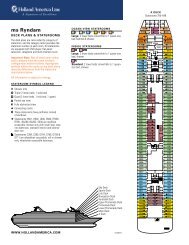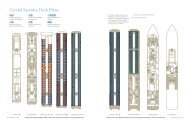Croatian cultural heritage - Business - Hrvatska turistiÄka zajednica
Croatian cultural heritage - Business - Hrvatska turistiÄka zajednica
Croatian cultural heritage - Business - Hrvatska turistiÄka zajednica
You also want an ePaper? Increase the reach of your titles
YUMPU automatically turns print PDFs into web optimized ePapers that Google loves.
5<br />
4<br />
6<br />
7<br />
8<br />
9<br />
11<br />
12<br />
The Split part of Dalmatia shared the same historical fate as other<br />
parts of Dalmatia, but because of its central position and protection<br />
by the vast hinterland, it was less exposed to devastation than its neighbouring regions.<br />
It is for this reason that so many people live here and that the Mediterranean spirit has<br />
been especially preserved. This is especially true for the city of Split, the largest city in<br />
Croatia after Zagreb, as the main <strong>cultural</strong> centre. Near Split are the other large coastal<br />
resorts of middle Dalmatia, Trogir and Omiš, while further south we have the picturesque<br />
Makarska Riviera. In front of Split, one next to the other, are almost all the large<br />
Dalmatian islands - Brač, Šolta, Čiovo, Hvar and Vis, and directed towards Split is the<br />
largest inland part of Dalmatia, with Sinj, Imotski, Vrlika and Vrgorac.<br />
10<br />
Although all of these areas are rich in <strong>cultural</strong> <strong>heritage</strong> dating from prehistoric times<br />
to recent times, what makes the central part of Dalmatia particular is the exceptionally<br />
well preserved <strong>heritage</strong> from the Antique period. There are the two most important<br />
ancient settlements of Dalmatia – the Ancient Greek Issa and the Roman Salon, and also the<br />
largest pearl of Croatia from the Antique period - the HISTORICAL HEART OF SPLIT, DIO-<br />
CLETIAN’S PALACE.<br />
A well known song says that the Roman Emperor Diocletian built his palace in "the most beautiful<br />
part of the world, in the heart of Split" (1), and it is not far from the truth. At the end of the<br />
3rd century, this Roman Emperor chose the location for his palace to be in this safe and quiet<br />
bay at the foot of the wooded hill Marjan, with beautiful islands stretching one after the other,<br />
where healing waters flow even today. The palace is almost an exact square shape, with sides<br />
about 200 metres long, and surrounded by high walls with numerous towers (2). The position<br />
of the palace is so valuable that this location was almost always constantly inhabited from then<br />
until this day and age, and it is still the centre of life in this great Dalmatian city.<br />
The Cathedral of St. Dujam (5), the patron saint of Split, has since the turn of the 4th century<br />
been located in the mausoleum of the Emperor Diocletian, which was slightly converted for this<br />
function and its interior was equipped with valuable religious items. In front of its entrance,<br />
a magnificent Romanesque bell tower was built in the 12th century. Its luxurious interior (3)<br />
is still a gathering place for believers, as well as many tourists. In front of the Cathedral is the<br />
Peristyle, the former space where the worship of Diocletian could be expressed, now gathering<br />
believers and tourists, and the unrivaled summer scene with mythical opera performances,<br />
especially Verdi's Aida (4).<br />
The Diocletian Palace now hosts many theatrical performances (8) and gathers Dalmatian<br />
Klapa singers (7) – it is where the daily life of Split goes on (11). In the vicinity are monu-<br />
97
















